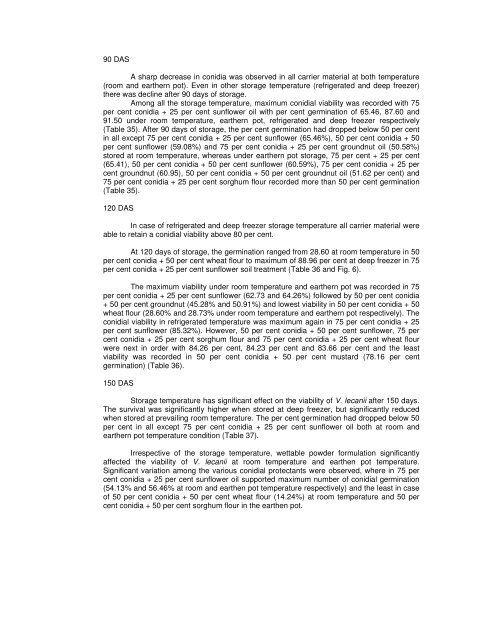ISOLATION AND CHARACTERIZATION OF ENTOMOPATHOGENIC ...
ISOLATION AND CHARACTERIZATION OF ENTOMOPATHOGENIC ...
ISOLATION AND CHARACTERIZATION OF ENTOMOPATHOGENIC ...
You also want an ePaper? Increase the reach of your titles
YUMPU automatically turns print PDFs into web optimized ePapers that Google loves.
90 DAS<br />
A sharp decrease in conidia was observed in all carrier material at both temperature<br />
(room and earthern pot). Even in other storage temperature (refrigerated and deep freezer)<br />
there was decline after 90 days of storage.<br />
Among all the storage temperature, maximum conidial viability was recorded with 75<br />
per cent conidia + 25 per cent sunflower oil with per cent germination of 65.46, 87.60 and<br />
91.50 under room temperature, earthern pot, refrigerated and deep freezer respectively<br />
(Table 35). After 90 days of storage, the per cent germination had dropped below 50 per cent<br />
in all except 75 per cent conidia + 25 per cent sunflower (65.46%), 50 per cent conidia + 50<br />
per cent sunflower (59.08%) and 75 per cent conidia + 25 per cent groundnut oil (50.58%)<br />
stored at room temperature, whereas under earthern pot storage, 75 per cent + 25 per cent<br />
(65.41), 50 per cent conidia + 50 per cent sunflower (60.59%), 75 per cent conidia + 25 per<br />
cent groundnut (60.95), 50 per cent conidia + 50 per cent groundnut oil (51.62 per cent) and<br />
75 per cent conidia + 25 per cent sorghum flour recorded more than 50 per cent germination<br />
(Table 35).<br />
120 DAS<br />
In case of refrigerated and deep freezer storage temperature all carrier material were<br />
able to retain a conidial viability above 80 per cent.<br />
At 120 days of storage, the germination ranged from 28.60 at room temperature in 50<br />
per cent conidia + 50 per cent wheat flour to maximum of 88.96 per cent at deep freezer in 75<br />
per cent conidia + 25 per cent sunflower soil treatment (Table 36 and Fig. 6).<br />
The maximum viability under room temperature and earthern pot was recorded in 75<br />
per cent conidia + 25 per cent sunflower (62.73 and 64.26%) followed by 50 per cent conidia<br />
+ 50 per cent groundnut (45.28% and 50.91%) and lowest viability in 50 per cent conidia + 50<br />
wheat flour (28.60% and 28.73% under room temperature and earthern pot respectively). The<br />
conidial viability in refrigerated temperature was maximum again in 75 per cent conidia + 25<br />
per cent sunflower (85.32%). However, 50 per cent conidia + 50 per cent sunflower, 75 per<br />
cent conidia + 25 per cent sorghum flour and 75 per cent conidia + 25 per cent wheat flour<br />
were next in order with 84.26 per cent, 84.23 per cent and 83.66 per cent and the least<br />
viability was recorded in 50 per cent conidia + 50 per cent mustard (78.16 per cent<br />
germination) (Table 36).<br />
150 DAS<br />
Storage temperature has significant effect on the viability of V. lecanii after 150 days.<br />
The survival was significantly higher when stored at deep freezer, but significantly reduced<br />
when stored at prevailing room temperature. The per cent germination had dropped below 50<br />
per cent in all except 75 per cent conidia + 25 per cent sunflower oil both at room and<br />
earthern pot temperature condition (Table 37).<br />
Irrespective of the storage temperature, wettable powder formulation significantly<br />
affected the viability of V. lecanii at room temperature and earthen pot temperature.<br />
Significant variation among the various conidial protectants were observed, where in 75 per<br />
cent conidia + 25 per cent sunflower oil supported maximum number of conidial germination<br />
(54.13% and 56.46% at room and earthen pot temperature respectively) and the least in case<br />
of 50 per cent conidia + 50 per cent wheat flour (14.24%) at room temperature and 50 per<br />
cent conidia + 50 per cent sorghum flour in the earthen pot.
















